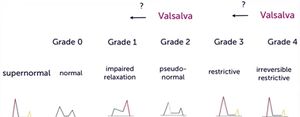Formal echocardiography: Difference between revisions
Neil.m.young (talk | contribs) (Text replacement - "doppler" to "Doppler") |
No edit summary |
||
| Line 50: | Line 50: | ||
===E/A Ratio=== | ===E/A Ratio=== | ||
*Measure of diastolic dysfunction | *Measure of diastolic dysfunction | ||
*PW Doppler across MV in apical view[[File: | *PW Doppler across MV in apical view bisecting across MV tips during opening, diastole | ||
*Tissue doppler at MV annulus (base) at either septum or lateral position to measure tissue velocity | |||
[[File:MVI and TDI.jpg|thumbnail|PW across Mitral Valve Opening and Tissue Doppler of Mitral Valve Annulus]] | |||
*The following rules will apply to most patients<ref>123sonography. Nov 20, 2010. https://www.youtube.com/watch?v=qdLkbcFe_DI.</ref>[https://www.youtube.com/watch?v=qdLkbcFe_DI (Video)] | *The following rules will apply to most patients<ref>123sonography. Nov 20, 2010. https://www.youtube.com/watch?v=qdLkbcFe_DI.</ref>[https://www.youtube.com/watch?v=qdLkbcFe_DI (Video)] | ||
#Rule 1: Normal diastolic function if echo normal, age<45 yrs, E>A | #Rule 1: Normal diastolic function if echo normal, age<45 yrs, E>A | ||
Revision as of 17:10, 8 October 2016
Diagnostic Pearls
- Normal directional flow in CW and PW in apical, parasternal short:
- Below the line for pulmonic and aortic valves (systole)
- Above the line in tricuspid and mitral valves (diastole)
Parasternal long
- Assess for mitral valve prolapse, systolic anterior motion
- Differentiate pleural effusion from pericardial effusion
- Pericardial effusion is anterior to descending aorta
- Pleural effusion posterior to descending aorta
Pericardial effusion vs. pleural effusion
- EPSS, E-Point Septal Separation in PSL view
- M-mode distance in mm between anterior leaflet of MV and septum in diastole
- E-point is shortest distance
- LVEF = 75.5 - 2.5 x EPSS in mm[1]
- EPSS and MRI LVEF correlated ~0.80 in study that generated equation
- Excluded MV prostheses, asymmetrical septal hypertrophy, significant aortic regurgitation
- Values as calculated by above study
- < 5 mm, normal
- > 7 mm, EF < 50%
- > 18 mm, EF < 30%
- Falsely elevated EPSS in:
- Mitral stenosis, rheumatic heart disease
- Mitral calcification
- Aortic regurgitation
- LV dilation
Parasternal short
Apical
- Best obtained in left lateral decubitus with L arm above head to open up ribs
- EF estimation
- LVEF by Simpson, LV volume change
- LVEF by Teichholz method, using M-mode (estimation of LV volume by diameter measured just beyond mitral tips in diastole)
- EF visual assessment:
- >65% = hyperdynamic
- 55-65% = normal
- 45-54% = mildly depressed
- 30-44% = moderately depressed
- <30% = severely depressed
Two chamber view
Three chamber view
Subxiphoid view
Suprasternal view
E/A Ratio
- Measure of diastolic dysfunction
- PW Doppler across MV in apical view bisecting across MV tips during opening, diastole
- Tissue doppler at MV annulus (base) at either septum or lateral position to measure tissue velocity
- Rule 1: Normal diastolic function if echo normal, age<45 yrs, E>A
- Rule 2: Impaired relaxation if A>E, with E/A<1
- Rule 3: Pseudonormal if echo abnormal (LVH), age>65, E>A, E/A>1
- Rule 4: Restrictive filling if E/A>2
See Also
- Aortic stenosis for CW Doppler measurements
External Links
References
- ↑ Silverstein JR et al. Quantitative Estimation of Left Ventricular Ejection Fraction from Mitral Valve E-Point to Septal Separation and Comparison to Magnetic Resonance Imaging. Jan 2006. Vol 97, Issue 1, Pg 137=140.
- ↑ 123sonography. Nov 20, 2010. https://www.youtube.com/watch?v=qdLkbcFe_DI.




